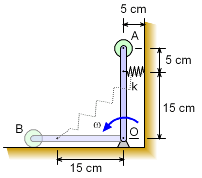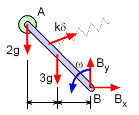| Ch 7. Rigid Body Energy Methods | Multimedia Engineering Dynamics | ||||||
| Rot. Work & Energy | Conservation of Energy | ||||||
| Conservation of Energy | Case Intro | Theory | Case Solution | Example |
| Chapter |
| - Particle - |
| 1. General Motion |
| 2. Force & Accel. |
| 3. Energy |
| 4. Momentum |
| - Rigid Body - |
| 5. General Motion |
| 6. Force & Accel. |
| 7. Energy |
| 8. Momentum |
| 9. 3-D Motion |
| 10. Vibrations |
| Appendix |
| Basic Math |
| Units |
| Basic Equations |
| Sections |
| Search |
| eBooks |
| Dynamics |
| Fluids |
| Math |
| Mechanics |
| Statics |
| Thermodynamics |
| Author(s): |
| Kurt Gramoll |
| ©Kurt Gramoll |
|
|
||
 Falling Rod with Spring |
Example |
|
|
A concentrated mass A of 2 kg is attached to the end of a 3 kg uniform slender rod. The rod is attached to the vertical wall with a spring 15 cm from the bottom pivot point. When the rod is vertical, it has an angular velocity, ω, of 2 rad/s. The undeformed length of the spring is 10 cm. Determine the spring modulus k such that the rod's angular velocity will be zero when it is fall to the horizontal. |
||
| Solution |
||
|
|
The system is conservative so the energy has be tot he same when vertical (1) and when horizontal (2), Moment of inertia of the rod and
mass about pivot point, B is The final kinetic energy, The final length of the spring is The final potential energy is, |
|
Practice Homework and Test problems now available in the 'Eng Dynamics' mobile app
Includes over 400 free problems with complete detailed solutions.
Available at the Google Play Store and Apple App Store.
